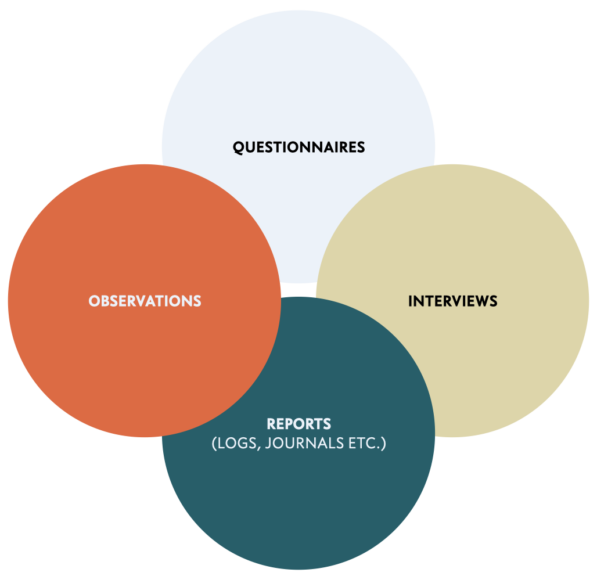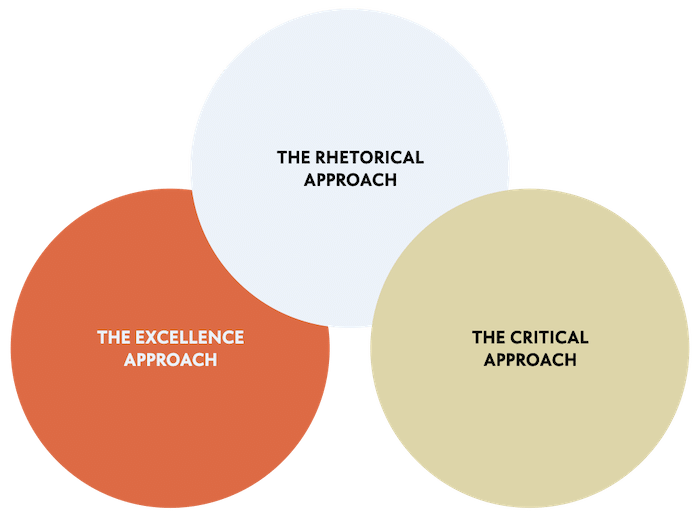How to measure public relations?
During a seminar on measuring public relations (PR) activities in social media, an audience member asked:
Is it possible to measure relationships?
Here, we get into challenging territory, and I will demonstrate why attitude- and behaviour measurements are superior to other types of measurements in public relations.
Here we go:
Methods for Measuring Public Relations
Spin Academy | Online PR Courses
Methods for Measuring Public Relations
There are three basic approaches to measuring public relations:
Please note: I recommend using the Sociological Method for measuring public relations.
The Traditional Method
The traditional measurement method is based on marketing logic. Marketing methods focus on media channels, demographic reach, and ad costs.
Examples of PR measurements:
Primary strength: Easy to calculate.
Primary weakness: Low quality for decision-making.
The Corporate Method
The corporate measurement method is based on general business practices. Corporate methods are focused on management theory and revenue. (Closely related to the Excellence PR Approach.)
Examples of PR measurements:
Primary strength: Fit well into corporate hierarchies.
Primary weakness: Misrepresent the value of PR.
The Sociological Method
The sociological measurement methodology is based on psychology. Behavioural methods are focused on attitudes and behaviours. (Closely related to the Rhetorical PR Approach.)
Examples of PR measurements:
Primary strength: Highly useful for PR.
Primary weakness: Not precise.
“Trust, openness, involvement, investment, and commitment are key dimensions in establishing and maintaining good organization-public relationships.“
Source: Public Relations Review 1Ledingham, J., & Bruning, S. (1998). Relationship management in public relations: dimensions of an organization-public relationship. Public Relations Review, 24, 55 – 65. … Continue reading
“Public relations models should be measured at the relational level and have a developmental component to better align with relationship management metaphors.“
Source: Public Relations Review 2Leichty, G., & Springston, J. (1993). Reconsidering public relations models. Public Relations Review, 19, 327 – 339. https://doi.org/10.1016/0363 – 8111(93)90055‑H
Learn more: Methods for Measuring Public Relations
💡 Subscribe and get a free ebook on how to get better PR.

How To Measure Public Relations
How To Measure Public Relations
How do you measure public relations (PR)? I recommend measuring attitudes and behaviours using questionnaires, rating scales, interviews, reports (logs, journals, diaries, etc.), and observations.

The general recommendation for PR measurement: I recommend the sociological method for getting valuable and actionable results from measuring public relations. This means measuring attitudes and behaviours. 3Silfwer, J. (2021, March 4). Methods of Measuring Public Relations. Doctor Spin | The PR Blog. https://doctorspin.net/measuring-public-relations/
Attitude Measurements in PR
There are a few things to consider when measuring attitudes and behaviours correctly. 4Educational Communications and Technology. (2001, August 3). 34.5 Measuring Attitudes. The Handbook of Research for Educational Communications and Technology. … Continue reading
An attitude measurement should meet the following criteria:
There are four main types of attitude measurement approaches:
There are four main types of attitude measurement methods:
Learn more: How To Measure Public Relations
My Preference: The Rhetorical Approach
Approaches To Public Relations
There are three scholarly approaches to public relations (PR):

The excellence PR approach = this public relations approach focuses on objectives and corporate value creation. The underlying motivation behind the theory was that public relations were mainly a variety of tactical tools that desperately needed a management theory to work well in a sophisticated organisation. 5Silfwer, J. (2022, November 6). PR Approaches: Excellence, Rhetorical, and Critical. Doctor Spin | The PR Blog. https://doctorspin.net/pr-approaches/
Notable mentions: James E. Grunig, Larissa A. Grunig
The rhetorical PR approach = this public relations approach stems from ideas dating back to ancient Greece. It’s a psychological theory of how communication structures human culture by shaping human minds. The rhetorical approach is practical and lacks moral judgment. 6Silfwer, J. (2022, November 6). PR Approaches: Excellence, Rhetorical, and Critical. Doctor Spin | The PR Blog. https://doctorspin.net/pr-approaches/
Notable mentions: Edward Bernays, The Toronto School of Communication Theory, Robert Heath
The critical PR approach = this public relations approach is deeply rooted in theories of societal power dynamics. Power is seen as a means of exerting dominance, manipulation, and oppression. The critical approach borrows many ideas from the rhetorical approach by placing them in moral frameworks. 7Silfwer, J. (2022, November 6). PR Approaches: Excellence, Rhetorical, and Critical. Doctor Spin | The PR Blog. https://doctorspin.net/pr-approaches/
Notable mentions: Walter Lippmann, Noam Chomsky
The Excellence Approach to PR
Management theory often focuses on operational excellence. The Excellence Study mapped value creation onto strategic communication and found that best practices create value for an organisation. They reduce costs and risks while increasing revenue.
“The programme of research known as the excellence theory began in the 1960s with J. Grunig’s research on publics found among Colombian farmers. Research then followed on the role of public relations in organisational decision-making, the symmetrical model of public relations, public relations measurement, and how the structure and environment of organisations shape public relations behaviour. […] The excellence theory has evolved into a general theory of public relations as a strategic management function, and ongoing research now is adding concepts and tools that public relations professionals who serve in a strategic role can use.”
Source: Excellence Theory in Public Relations: Past, Present, and Future 8Grunig, J.E., & Grunig, L.A. (2008). Excellence Theory in Public Relations: Past, Present, and Future. https://www.semanticscholar.org/paper/ccfadd878d41454375357ce99ec7fcb148e6b48f
How can PR have such best practices? The answers are, non-surprisingly, management-focused: Leadership roles, goal alignments, high levels of strategic competency, high ethical standards, and two-way symmetric communication with corporate stakeholders.
Who typically prefers the excellence approach?
The Rhetorical Approach to PR
In ancient Greek society, public debate and persuasion were considered the best approaches to ensuring peaceful and stable governance. This was the cradle of ideas like democracy and free speech. There was no best practice, only outcomes from multiple voices.
“Rhetorical theory features how the public relations process becomes enriched through the role co-created, shared meaning plays in society as a blend of mind and self. The rhetorical heritage features the potent role of fact (as interpreted information), judgment, and identification as discourse themes enacted in public arenas. Public relations can add value to society by assuring that choices become enlightened, risks are ethically managed, and relationships are mutually developed. Through ethical rhetorical practice that results from the reflective character of organisations, public relations helps society to be more fully functioning.”
Source: Rhetorical Perspective and Public Relations: Meaning Matters 9Heath, R. L., & Frandsen, F. (2008). Rhetorical Perspective and Public Relations: Meaning Matters. VS Verlag Für Sozialwissenschaften EBooks, 349 – 364. … Continue reading
If you hear a PR professional talk passionately and positively about the importance of persuasion and perception management, they are most likely supporters of the rhetorical approach. They’re focused on language and relationships and think of society descriptively.
Many modern rhetorical concepts have stemmed from the Toronto School of Communication Theory and were later refined and further developed by Robert L. Heath.
Who typically prefers the rhetorical approach?
The Critical Approach to PR
“Critical theory” is a broad term encapsulating tools for analysis from various fields. Examples of such devices for analysis are feminism, cultural studies, structuralism, semiotics, and postmodernism. As a broad approach, it offers a wide range of scholarly criticism.
“The dominance of Excellence Theory in public relations theory and research may be eroding as contemporary issues in corporations, including the concern with activist challenges to reputation management and corporate social responsibility, increase in visibility and demand explanation. […] Excellence Theory’s acknowledgement of once-vilified concepts like persuasion and power sets the stage for critical public relations theory and research to emerge as significantly more capable of addressing activist advocacy and concomitant issues. The paper argues that critical theory, buoyed by acceptance of its key concepts, its increasing access to presentation venues and journals sympathetic to once-marginalised, alternative perspectives, is poised to infiltrate the public relations orthodoxy.”
Source: Public Relations Review 10Coombs, W. T., & Holladay, S. J. (2012). Fringe public relations: How activism moves critical pr toward the mainstream. Public Relations Review, 38(5), 880 – 887. … Continue reading
Since critical PR theory borrows from various scholarly traditions, it’s challenging to summarise the critical approach. But there’s often a focus on societal power dynamics and detailed victimology. The critical approach has many touch points with the rhetorical approach, but they tend to end up on opposite sides of the excellence approach:
While the rhetorical approach finds the excellence approach too normative, the critical approach isn’t normative enough.
Who typically prefers the rhetorical approach?
Read also: 3 PR Approaches: Excellence, Rhetorical, and Critical
The Close Relationship Argument
“Not everything that counts can be counted. And not everything that can be counted, counts.”
— Albert Einstein
In the rhetorical approach, PR is all about relationships. And I tend to agree wholeheartedly with that sentiment.
And in life, some relationships are more important than others. My most important and closest relationships are those with my wife and son. Those are my most valuable relationships.
What if I wanted to measure those relationships?
I could measure various metrics, from my wife’s salary to my son’s grades. But my wife could make good money, and my son could do well in school despite having an awful relationship with me.
What’s the best way for me to gauge my closest relationships? For results that matter and are helpful, engage in open and continuous conversation and codify outcomes. So, in my view, communication is the best way to measure relationships.
Most relationships aren’t that close, but they’re still relationships that shape attitudes and behaviours.
Money, Money, Money
Most companies are managed via one single principle—money.
Money defines their success.
Money dictates their governance.
Money functions as their prime motivator.
We all care about money, businesses and people, but that’s not how we form trust and deep relationships.
Money is a great central value for nearly everything except for one thing: relationships with other humans.
Only measuring public relations by how to squeeze more money out of every relationship means treating your publics like wallets with legs. And that would be a shame because human beings have so much more to give other than just their money.
In the eyes of funnel fundamentalists, we are demographic entities stripped of our essence, mere puppets of consumption with wallets in place of hearts.
Some argue that money is how everything in an organisation gets measured, so the PR function must conform. I take the opposite view: If so, at least one function should focus on the human aspect.
Read also: Why ROI and PR Mix Like Oil and Water
The Golden Rule of Measuring PR
“What gets measured, gets done.”
— Peter Drucker
Spin Academy | Online PR Courses
The Golden Rule of Measuring PR
If an organisation focuses on the wrong metrics, it might establish, maintain, or develop the wrong long-term relationships. 11The insight is based on 18+ years of practical consulting experience.
The Golden Rule of Measuring PR: Your choice of PR measurement method and trackable PR objectives will impact your organisation more than the resulting measurements ever will.
Choosing the measurement method and objectives for public relations is more critical than getting the actual data from those trackings.
Learn more: The Golden Rule of Measuring PR
💡 Subscribe and get a free ebook on how to get better PR.

The Barcelona Principles 3.0
Spin Academy | Online PR Courses
Barcelona Principles 3.0
The PR industry has united around a series of principles for measuring communications. The latest iteration comes from AMEC, the International Association for Measurement and Evaluation of Communication.
1. Setting goals is an absolute prerequisite to communications planning, measurement, and evaluation—The founding principle of SMART (specific, measurable, actionable, relevant, and time-bound) goals as a foundation for communications planning has been promoted to an essential prerequisite. It pushes measurement and evaluation as a core component of the planning process, articulating target outcomes and how progress towards these will be assessed.
2. Measurement and evaluation should identify outputs, outcomes, and potential impact—Previously, the Principles recommended measuring outcomes, rather than simply counting outputs. The updated principles extend this to consider longer term impact of communications strategy. According to Levine, this means thinking about “the channels we are impacting, and change we would like to see through campaigns, events and activations.”
3. Outcomes and impact should be identified for stakeholders, society, and the organisation—From the original focus on business metrics, such as sales and revenue, the 2020 update embraces a more holistic view of performance. It allows the model to be more inclusive of a broader range of organisations and communications roles that are not necessarily profit-driven.
4. Communication measurement and evaluation should include both qualitative and quantitative analysis—“To understand the full impact of your work, it is crucial that you use the full suite of methods to measure those outcomes,” summarised Levine in describing the evolution of this principle to not just quantify but also understand how messages are being received, believed and interpreted.
5. AVEs are not the value of communication—The message remains consistent and clear; “we continue to believe that AVEs do not demonstrate the value of our work.” It is important that communications measurement and evaluation employs a richer, more nuanced, and multi-faceted approach to understand the impact of communications.
6. Holistic communication measurement and evaluation includes all relevant online and offline channels—Our founding principle that social media can and should be measured is so obvious today. The 2020 iteration reflects the game-changing shift in social communications’ capabilities, opportunities, and influence, such that all relevant online and offline channels should be measured and evaluated equally. The AMEC measurement framework promotes clarity across earned, owned, shared, and paid channels to ensure consistency in approach towards a common goal.
7. Communication measurement and evaluation are rooted in integrity and transparency to drive learning and insights—Sound, consistent, and sustained measurement calls for integrity and transparency in recognition of today’s attention to data privacy and stewardship as organisations comply with new regulations, such as GDPR. This is also a statement that measurement isn’t simply about data collection and tracking, but about learning from evaluation and applying insight back into communications planning. It recognises the need to be transparent about the context in which programmes are run and being aware of any bias that may exist in the tools, methodologies and interpretations applied.
Download the Barcelona Principles 3.0 Presentation here
Learn more: How To Measure Public Relations
💡 Subscribe and get a free ebook on how to get better PR.

Public Relations Objectives
Public Relations Objectives
“Public relations is a young academic field with potential to inform various areas of communication and offer tools like issues management for various applied communication fields.“
Source: Journal of Communication 12Botan, C., & Taylor, M. (2004). Public relations: State of the field. Journal of Communication, 54, 645 – 661. https://doi.org/10.1111/J.1460 – 2466.2004.TB02649.X
Building trust and credibility is a crucial objective of public relations. In an era where consumers are increasingly sceptical of advertising and corporate speak, PR offers a more authentic and credible way to communicate with the public.
But what exactly are PR professionals focused on achieving?
Categorised by the stakeholder model, here are examples of common public relations objectives:
Corporate Communications Objectives
The primary objective of corporate communications is to strategically manage and convey an organisation’s messages to internal and external stakeholders, publics, and influencers while fostering a consistent brand image, trust, engagement, and alignment with business goals.
Corporate communications = an organisation’s strategic use of messaging to shape its reputation, articulate its vision, and engage with key audiences across internal and external channels.
Targets: External and internal publics, business journalists, regulatory institutions, partners, suppliers, vendors, etc.
Examples of objectives:
Investor Relations Objectives
The primary objective of investor relations is to effectively communicate a company’s financial performance, strategy, and value proposition to current and potential investors, fostering trust, transparency, and support for the company’s long-term objectives.
Investor relations (IR) = an organisation’s deliberate communication efforts to build trust and maintain transparency with investors, analysts, and the financial community.
Targets: Shareholders, investors, market hubs, market analysts, financial institutions, trade journalists etc.
Examples of objectives:
Media Relations Objectives
The primary objective of media relations is to build and maintain positive relationships with influencers, journalists, and media outlets to ensure accurate, consistent, and favourable coverage of an organisation’s messages, initiatives, and reputation.
Media relations = a brand’s targeted use of communication to foster positive interactions with journalists, editors, and media outlets and to gain favourable coverage.
Targets: Journalists, editors, influencers, etc.
Examples of objectives:
Digital PR Objectives
The primary objective of digital PR is to enhance an organisation’s online presence and reputation by leveraging digital platforms, creating shareable content, and securing high-quality inbound traffic to drive visibility, engagement, and authority.
Digital PR = the strategic use of online communication to build brand communities, foster engagement, and manage reputation in the digital space. 13Silfwer, J. (2017, November 20). What is Digital PR? Doctor Spin | The PR Blog. https://doctorspin.net/what-is-digital-pr/
Targets: Inbound web traffic, brand communities, subscribers, fans, followers, influencers, social networks, etc.
Examples of objectives:
Public Affairs Objectives
The primary objective of public affairs is to influence public policy, legislation, and societal attitudes through strategic communication and advocacy to foster mutually beneficial relationships between organisations and governmental or regulatory stakeholders.
Public affairs (PA) = a brand’s intentional use of communication to engage with governments, policymakers, and communities to influence public policy and social impact.
Targets: Voters, political journalists, political analysts, columnists, interest groups, etc.
Examples of objectives:
Lobbying Objectives
The primary objective of lobbying is to influence decision-makers, particularly legislators and government officials, to support specific policies, regulations, or actions that align with an organisation’s or advocacy group’s interests.
Lobbying = the focused use of advocacy and communication to directly influence legislative and regulatory decisions in favour of specific interests or causes.
Targets: Politicians, legislators, government officials, committees, influencers, etc.
Examples of objectives:
Internal Communications Objectives
The primary objective of internal communications is to engage, inform, and align employees with the organisation’s goals, culture, and strategies, fostering collaboration, motivation, and a sense of shared purpose.
Internal communications (IC) = an organisation’s deliberate use of messaging to align, inform, and motivate employees while fostering a productive workplace culture.
Targets: Coworkers, potential recruits, etc.
Examples of objectives:
Crisis Communications Objectives
The primary objective of crisis communications is to protect and restore an organisation’s reputation, trust, and stability by managing the flow of accurate, timely, and strategic information during and after a crisis.
Crisis communications = a brand’s rapid, strategic deployment of communication to mitigate reputational damage, address urgent challenges, and restore public trust during critical situations.
Targets: Crisis victims, worried publics, the general public, coworkers, journalists, influencers, customers, shareholders, etc.
Examples of objectives:
Marketing PR Objectives
The primary objective of marketing PR is to generate awareness, interest, and demand for products or services by leveraging earned/shared/owned media, storytelling, and influencer engagement to complement marketing efforts and enhance brand credibility.
Marketing PR = a brand’s tactical integration of communication and promotional efforts to enhance product awareness, drive sales, and support marketing objectives.
Targets: Potential customers, existing customers, trade journalists, members, affiliates, etc.
Examples of objectives:
Industry PR Objectives
The primary objective of industry PR (B2B) is to build credibility, foster trust, and enhance thought leadership within a specific industry by communicating value, expertise, and innovations to business publics, niche influencers, and stakeholders.
Industry PR (B2B) = a business’s purposeful use of communication to build credibility, foster trust, and establish thought leadership within its professional sector.
Targets: B2B clients, B2B prospects, trade journalists, trade organisations, niche influencers, etc.
Examples of objectives:
Learn more: Public Relations Objectives

THANKS FOR READING.
Need PR help? Hire me here.

PR Resource: Free Corporate PR Course
Spin Academy | Online PR Courses

Spin’s PR School: Free Corporate PR Course
Explore this Free Corporate PR Course to learn strategic communication insights and techniques and stay ahead in the competitive public relations industry.
Corporate Communications
Agency Collaboration
Corporate Messaging
Corporate Challenges
Learn more: All Free PR Courses
💡 Subscribe and get a free ebook on how to get better PR.

Annotations
| 1 | Ledingham, J., & Bruning, S. (1998). Relationship management in public relations: dimensions of an organization-public relationship. Public Relations Review, 24, 55 – 65. https://doi.org/10.1016/S0363-8111(98)80020 – 9 |
|---|---|
| 2 | Leichty, G., & Springston, J. (1993). Reconsidering public relations models. Public Relations Review, 19, 327 – 339. https://doi.org/10.1016/0363 – 8111(93)90055‑H |
| 3 | Silfwer, J. (2021, March 4). Methods of Measuring Public Relations. Doctor Spin | The PR Blog. https://doctorspin.net/measuring-public-relations/ |
| 4 | Educational Communications and Technology. (2001, August 3). 34.5 Measuring Attitudes. The Handbook of Research for Educational Communications and Technology. https://members.aect.org/edtech/ed1/34/34 – 05.html |
| 5, 6, 7 | Silfwer, J. (2022, November 6). PR Approaches: Excellence, Rhetorical, and Critical. Doctor Spin | The PR Blog. https://doctorspin.net/pr-approaches/ |
| 8 | Grunig, J.E., & Grunig, L.A. (2008). Excellence Theory in Public Relations: Past, Present, and Future. https://www.semanticscholar.org/paper/ccfadd878d41454375357ce99ec7fcb148e6b48f |
| 9 | Heath, R. L., & Frandsen, F. (2008). Rhetorical Perspective and Public Relations: Meaning Matters. VS Verlag Für Sozialwissenschaften EBooks, 349 – 364. https://doi.org/10.1007/978 – 3‑531 – 90918-9_23 |
| 10 | Coombs, W. T., & Holladay, S. J. (2012). Fringe public relations: How activism moves critical pr toward the mainstream. Public Relations Review, 38(5), 880 – 887. https://doi.org/10.1016/j.pubrev.2012.02.008 |
| 11 | The insight is based on 18+ years of practical consulting experience. |
| 12 | Botan, C., & Taylor, M. (2004). Public relations: State of the field. Journal of Communication, 54, 645 – 661. https://doi.org/10.1111/J.1460 – 2466.2004.TB02649.X |
| 13 | Silfwer, J. (2017, November 20). What is Digital PR? Doctor Spin | The PR Blog. https://doctorspin.net/what-is-digital-pr/ |


